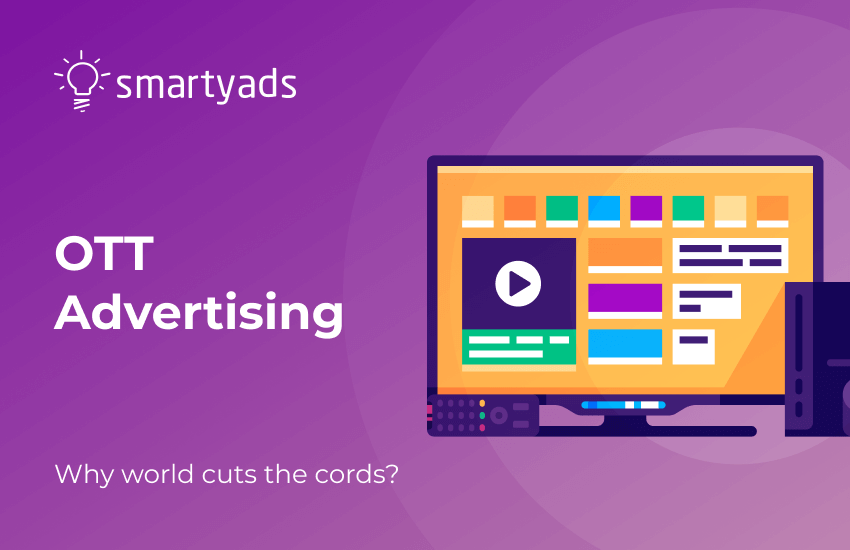OTT (stands for over the top) advertising and TV ad tech platforms popped up on the scene back in 1990, with a dawn of the Internet era. All of the new broadcasting methods appeared – CTV, Addressable, and Over the top.
So, what is OTT marketing and how to leverage it properly? First, let’s review the popular OTT and CTV notions to discover their differences.
Connected TV (CTV)
The word “connected” is referring to an Internet connection. CTV is enabled by gaming consoles, PlayStation, Xbox, Amazon Fire TV, Apple TV, online TV streaming services like Netflix, Hulu, Smart TV, and cable providers. Read more about Connected TV Advertising here.
Addressable TV
This method delivers specific content to a specific OTT audience. Think of it as content with the “address” of a specific audience on it. Addressable TV is enabled by the same technologies as connected TV. Read more about Addressable TV Advertising here.
OTT (over the top)
This method allows advertisers to deliver content to those people who do not want to pay for cable. This form of contention is currently in demand and offers many advantages to both TV advertisers and viewers.
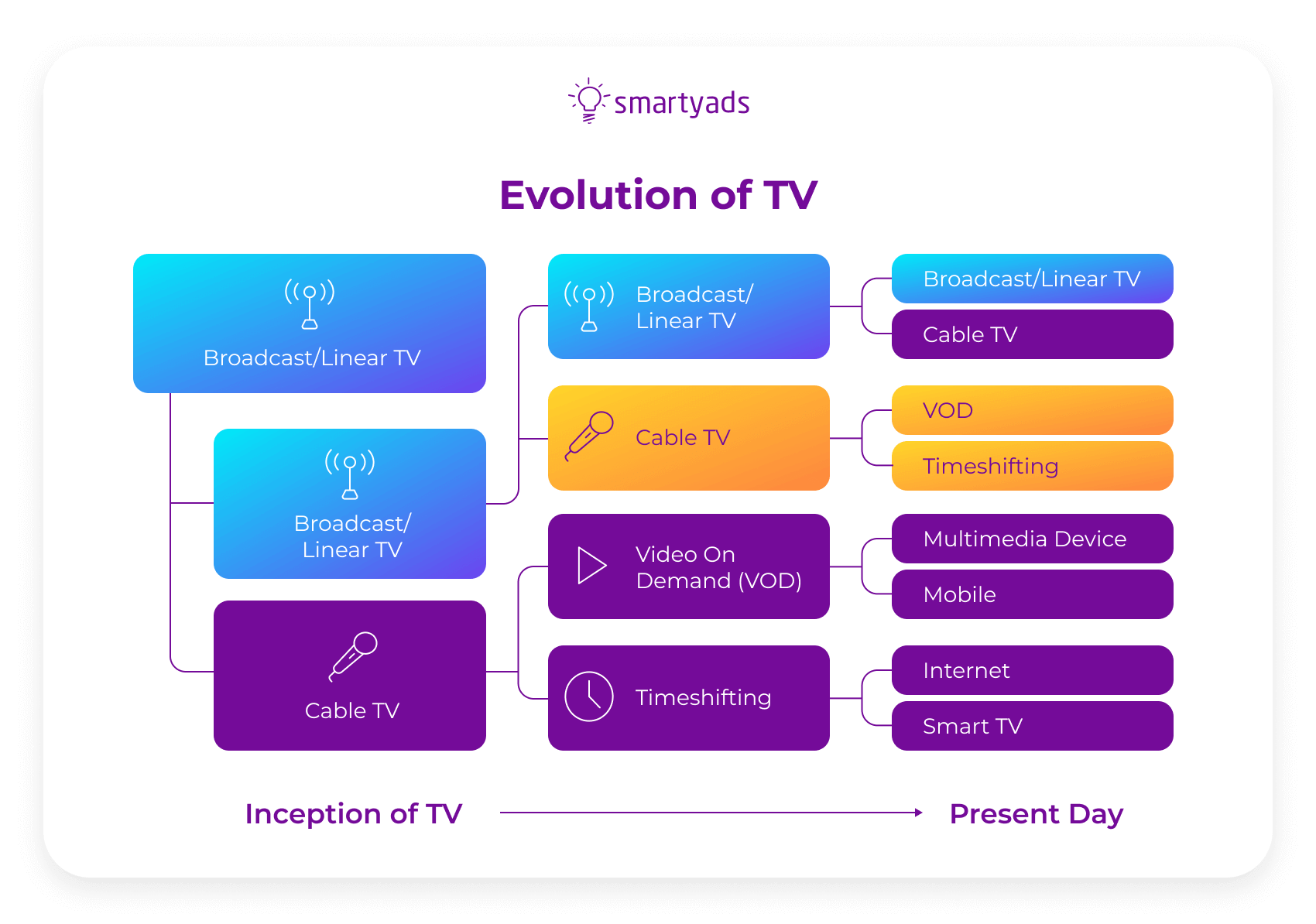
How Over The Top (OTT) is different from IPTV?
From a technical standpoint, both IPTV and OTT services process requests and deliver content through Internet protocol.
However, the OTT content will go through the open network and the IPTV service will use a private network that can be managed. This makes OTT and IPTV streaming video services very similar if we talk about technology.
Typically, IPTV services are delivered by an Internet provider. Therefore, one IPTV service cannot be used with two different providers.

The benefits of OTT and IPTV
With OTT streaming services customers access:
- Very affordable streaming content for the pricing that typically reaches $5-10 per month;
- No specific equipment is needed for streaming — just a phone or a tablet will work (although Apple TV and special streaming TV boxes improve the quality of experience);
- Variety of programming options, like multichannel video programming distributors (MVPDs). Services nowadays offer lots of options when it comes to original programming.
Meanwhile, customers use IPTV streaming services because:
- They offer an uninterrupted and glitch-free experience due to the fact that private network broadcasting is more controllable;
- Programming: on-demand viewership is very convenient;
- No specific equipment is needed for streaming, only a set-top box (if you already have a broadband Internet connection).
What is OTT Advertising?
What does OTT stand for in advertising and how does OTT advertising work?
OTT advertising is individualized streaming content provided to the viewers' TV sets while they watch the same TV show.
Thanks to OTT, advertisers can expand their audience reach that previously was only available on linear TV. Therefore, if you are an ad tech pioneer and you know how to launch effective OTT marketing, you will be reaping great rewards.
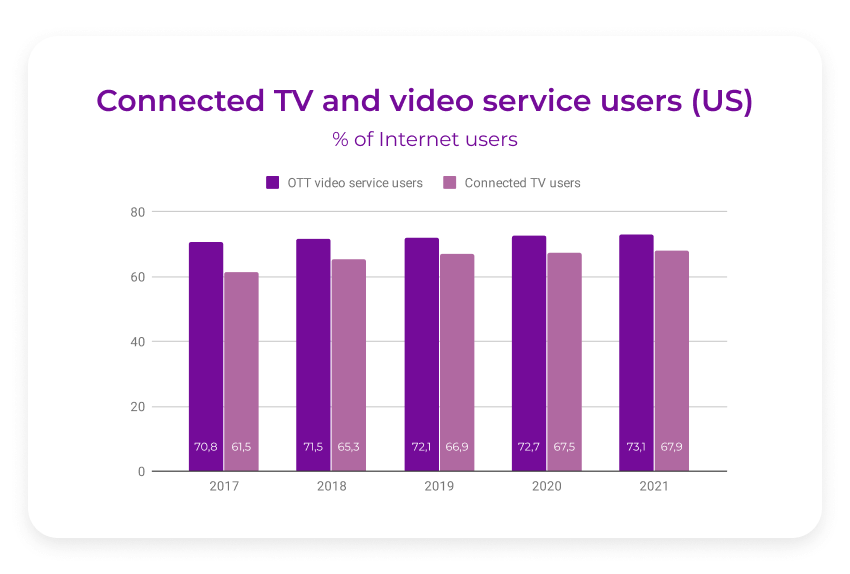
What do OTT ads look like?
OTT video advertising is the most popular format. It is not always skippable is usually watched until the end. Most frequently those online video ads overlay video content helping brands to share their brand messages with unique and relevant audiences.
For programmatic platforms that support various kinds of ad formats serving a video advertising or banner creative won’t be a problem. At the same time, OTT video ads and banners are so far the most common ones.

5 Types of over the top ads
As mentioned above, video ads are the most popular formats, especially in OTT programmatic. However, there are more formats to look at:
Pre-rolls
Pre-roll ad units are video commercials. They have a duration of 15-30 seconds and appear before the video content.
Mid-rolls
Those ad units run for 30 seconds to several minutes. They appear after some portion of the video is already watched by the viewer.
Post-rolls
Post-roll ad units appear after the viewer has watched the main content. Their duration can reach several minutes.
Banners
Banners are static ad creatives and they normally appear at the top or the bottom of the main screen.
Overlays
Appearing on the top of the content, these ads can contain the link that leads users to the landing page.
How to create affordable OTT advertising campaigns
So, how to use OTT in advertising so that you don’t overspend?
Make a research on ad platforms
If the platform offers advertising on OTT, compare their prices and targeting capabilities, and find out if the inventory they offer matches your quality criteria for suitable ad placements.
See what creatives they offer
If you run a video creative look for shorter-duration options. For instance, popular 5-second online video ads will cost way cheaper than broadcasting 20-second creative.
Exclude irrelevant impressions
Narrowing down your audience with targeting will help you to increase the likelihood of conversion and decrease ad spend while serving over the top ads.
Analyze
Use in-built OTT platform tools to generate reports and analyze what works and what doesn’t.
Limit the frequency
On programmatic platforms, advertisers can limit the number of times the ad will be shown to the user (per day) — ad frequency. This way, the ad won’t appear annoying to the users and will also prevent you from overspending.
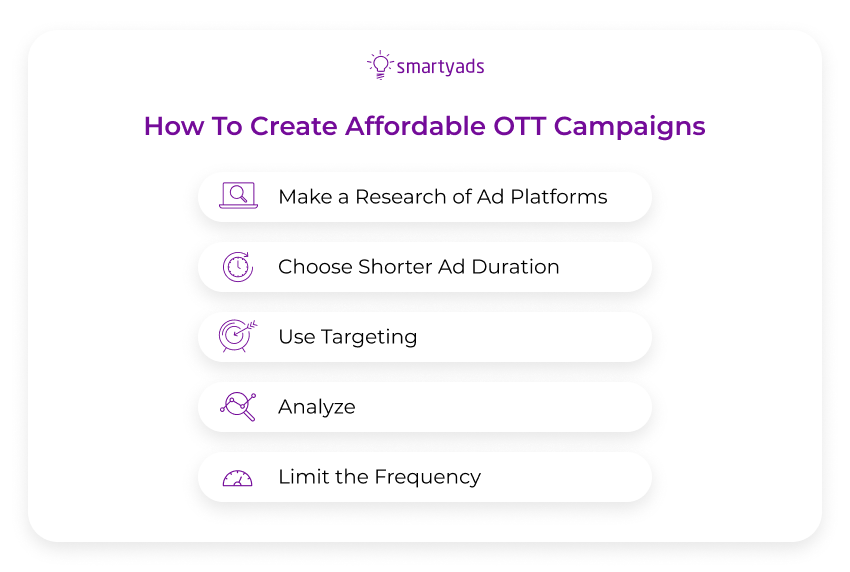
How is Over the Top Advertising Delivered?
The delivery method depends on the live TV streaming service and how their platforms interact with OTT devices (whether it is Roku, Amazone Fire TV, Amazon Prime Video, Apple TV, YouTube TV, or something else).
For example, this could be through the Video Ad Serving Template (VAST) since OTT video content is very popular. In this case, the ad insertion could be performed via server-side (SSA) or client-side (CSAI).
How do SSA and CSAI work
- The audience for your OTT advertising campaign is created. The composition of this audience will be based on the data obtained from the platform.
- Launching of the campaign. The ad platform will connect the audience to a particular TV subscriber list across all OTT platforms.
- The ad-supported streaming video will be channeled to the audiences. Various tags will be used to tell the OTT media player how a particular ad should appear to the viewer.
- The final stage involves the OTT ads platform sending a report back to the advertiser which contains info about the ad.

Why is OTT Popular Now and How Does it Impact OTT Ads?
OTT can provide users with a wide variety of payment and viewing options. It also allows the viewers to free themselves of contracts that their cable providers locked them into.
Computers, tablets, and smart TVs are changing the game
For the consumer, one of the biggest benefits of OTT is being able to stream video content over many devices. A lot of the OTT apps let people enjoy content on their computers, tablets, smart TVs, and even gaming consoles. With this, when it comes to video streaming, the majority of people prefer to use mobile and tablets rather than desktop devices.
Benefits for advertisers
What are the most drastic benefits of OTT digital advertising? The biggest benefit is that people who are watching content on OTT advertising platforms cannot skip ads, close a window, install some kind of ad-blocking software, or any other ‘ad shield’.
OTT video ads completion rate is sky-high on OTT platforms and cannot be compared with much lower numbers of in-browser ads.
OTT usage statistics
- The overall worth of the OTT market is predicted to grow by $1.039 trillion by 2027;
- The most popular device used for OTT streaming in the USA is Roku, which accounts for 27% of overall TV watching;
- According to the Statista report, around 51.58% of OTT market revenues come from video-on-demand (AVOD), and 40.16% from the subscription-video-on-demand model (SVOD);
- Transactional Video-On-Demand (TVOD) generates 5.1%, and 3.16% comes from video downloads. It shows that transactional video-on-demand (TVOD) clearly loses out to subscription video-on-demand and video-on-demand;
- According to eMarketer, around 30.8% of all subscriptions come to the most popular OTT streaming service — Netflix;
- OTT digital video advertising revenue per user will be boosted by 72% during the next couple of years. By 2025 it will reach $52.25;
- According to TDG research, currently, the average length of an ad is 3.2 minutes, and it will rise to 5.1 minutes. The total ad spending on OTT will reach $2.373 billion by the end of 2025.
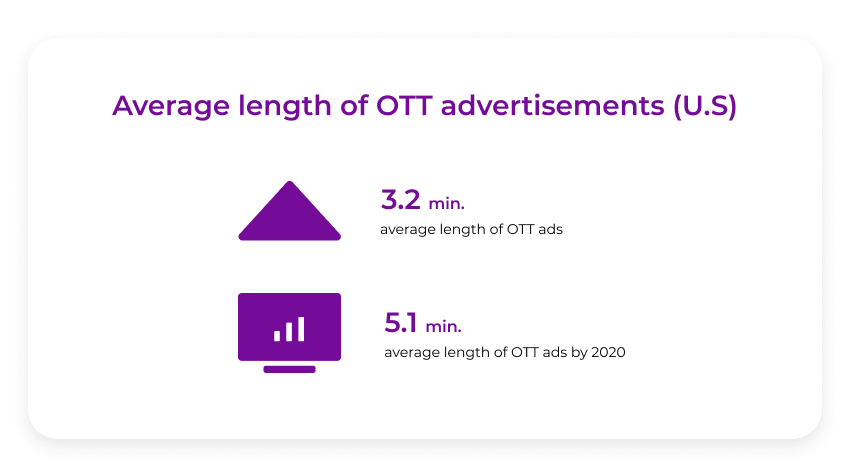
Benefits of Over the Top Advertising
OTT also offers a lot of benefits to advertisers:
Targeting
OTT enables shorter but more relevant ads because it knows where the audience is located geographically. OTT platform can break the audience into segments for better metrics, and it can tell you which device(s) the viewers are using most often to access your content.
Dynamic ad insertion
This lets you interchange banners or video ads in linear, live, or video-on-demand content. VOD or video-on-demand is a media distribution system that enables accessing videos without traditional video playback devices and limitations of traditional broadcast advertising like broadcasting schedules.
Analytics
With all of the data obtained about your OTT audience, you can find which OTT ads are working for you and which ones are not to optimize future ads with the insights you obtained.
Challenges of OTT Advertising
There are still some problems that need to be resolved before we can finally declare that over the top TV advertising is a perfect digital advertising medium.
Management and measurability
On OTT platforms, it is still difficult to measure engagement and user reaction since OTT ads are not measured using metrics such as clicks. However, an OTT ad supported by programmatic platforms can be measured according to several metrics commonly used in ad tech; cost per thousand impressions (CPM) is the most common of them.
Regulations
OTT advertising is kind of the Wild West, i.e. there are no rules or regulations that govern the quality of OTT inventory and OTT media so far.
Ad fraud prevention here is very important. While it is not as vulnerable as something like desktop computers, ad fraud has managed to find its way into OTT and could pose significant problems.
Functionality
A lot of OTT devices do not have the same functionalities as web browsers. For example, if you run an ad creative in an Internet browser, you can obtain all kinds of information from the tracking pixel or cookie that will give you insights considering the conversion rate of a particular source.
This is not possible right now on some OTT devices. VPAID was introduced to enhance ad experiences and provide ad performance insights.
OTT Ad Insertion Methods
CSAI
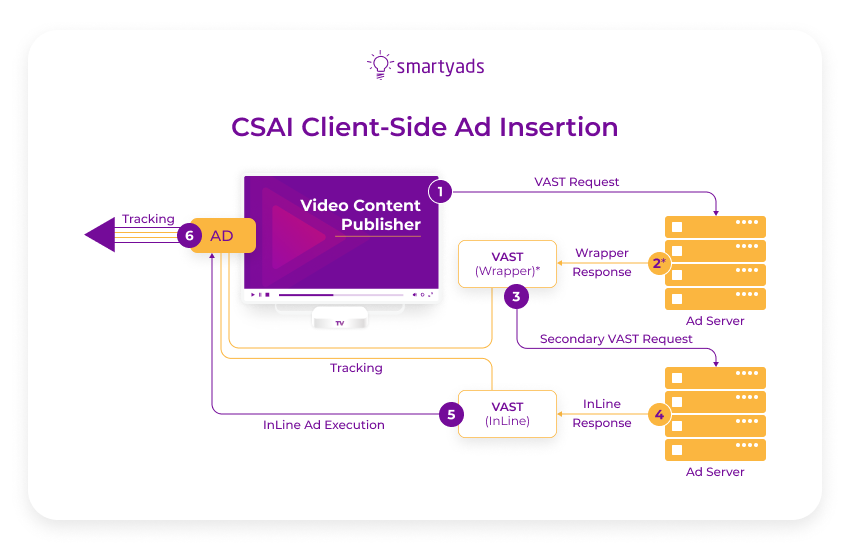
Client-side ad insertion (CSAI) is the old method when the advertiser inputs the ad into the platform before the viewer sees it. Even though today most of the ads are served to the viewer through this method, there are some drawbacks.
First of all, there is an excellent chance that your ad will get caught by the ad blocker and will never get to the viewer. Also, it features lower-quality of streaming services because the player often switches back and forth between OTT content and advertisements.
SSAI or “Stitching”
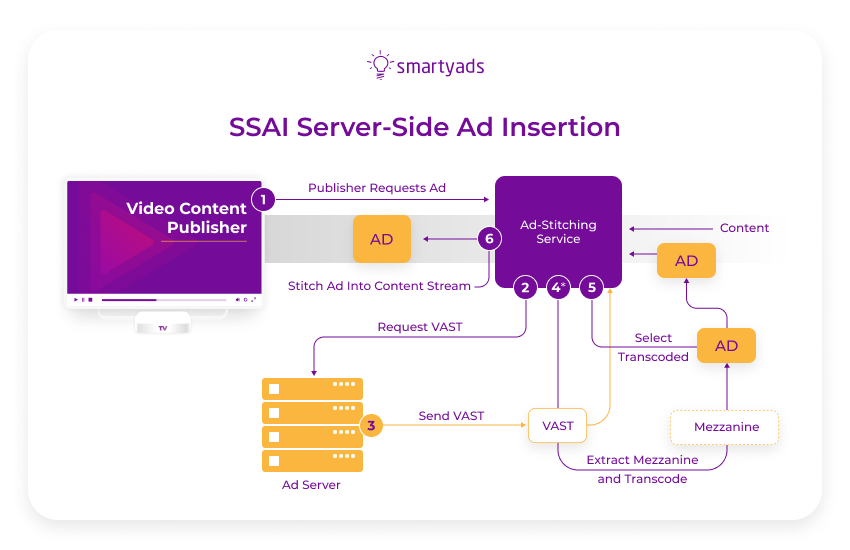
SSAI stands for server-side ad-insertion content delivery. By utilizing this method, you can display the ads to your audience without any interruptions. In essence, it is a real-time combination of the ads and core content.
What’s great about this method is that the viewer sees it one frame at a time, thus making it difficult for ad blockers to spot.
There are many providers out there who underestimate ad insertion functionality. However, some OTT advertising platforms go above and beyond in order to provide their clients with metrics and interactivity that feature VPAID tags built-in.
Tags Used for Communicating With OTT Devices
VAST Tags
OTT advertising is specific because it demands different standards. The VAST tags are important because they determine how the OTT video ads will display. They tell the player everything, starting from where the ad should appear on the screen, for how long, and everything else concerning the ad’s appearance.
VPAID Tags
Video Player-Ad Interface Definition (VPAID) tags build on the capabilities of VAST, making the ad interactive and adding metrics.
It provides better insights and metrics in terms of viewability and might even offer some interactivity. Therefore, if the stitching is not a deal-breaker for you, this could be the best option among all other tags.
The Future of OTT
The future of OTT advertising is bright despite all of the obstacles.
Subscriptions
Most providers that offer streaming services like Netflix or Hulu receive the biggest portions of their revenue from subscriptions the customers are paying for.
This is great because the advertisers will know where their audience is located and therefore, will be able to tailor their offers much better.
Streaming services and precise targeting
In the next round, the targeting will remain based on the audience’s viewing data obtained from the provider or the streaming service (geo, device type, etc).
In addition, ad-supported OTT services allow matching devices with other ones located inside the users’ homes substantially enhancing this data with information about browsing and online shopping history to make the targeting even more precise.
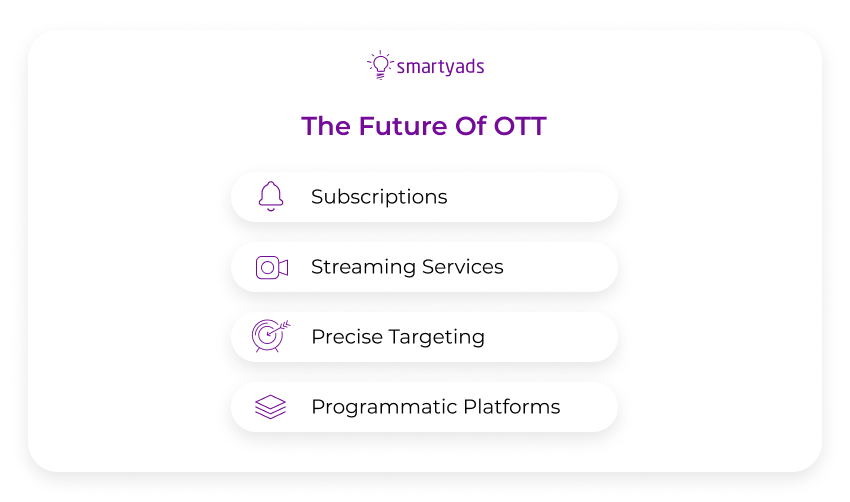
Soon OTT ads will be available for both private and public auctions on any demand-side platform that supports these creative formats. This will allow brands to get the most out of their ad campaigns by targeting based on intent. As well OTT supports retargeting capabilities.
The viewability will also increase because the OTT content offered to these audiences will be better suited to products they are interested in. Serving OTT ads via SSP will also be beneficial for publishers who want to keep their users engaged instead of repelled. Below you can see types of programmatic TV and what it supports.
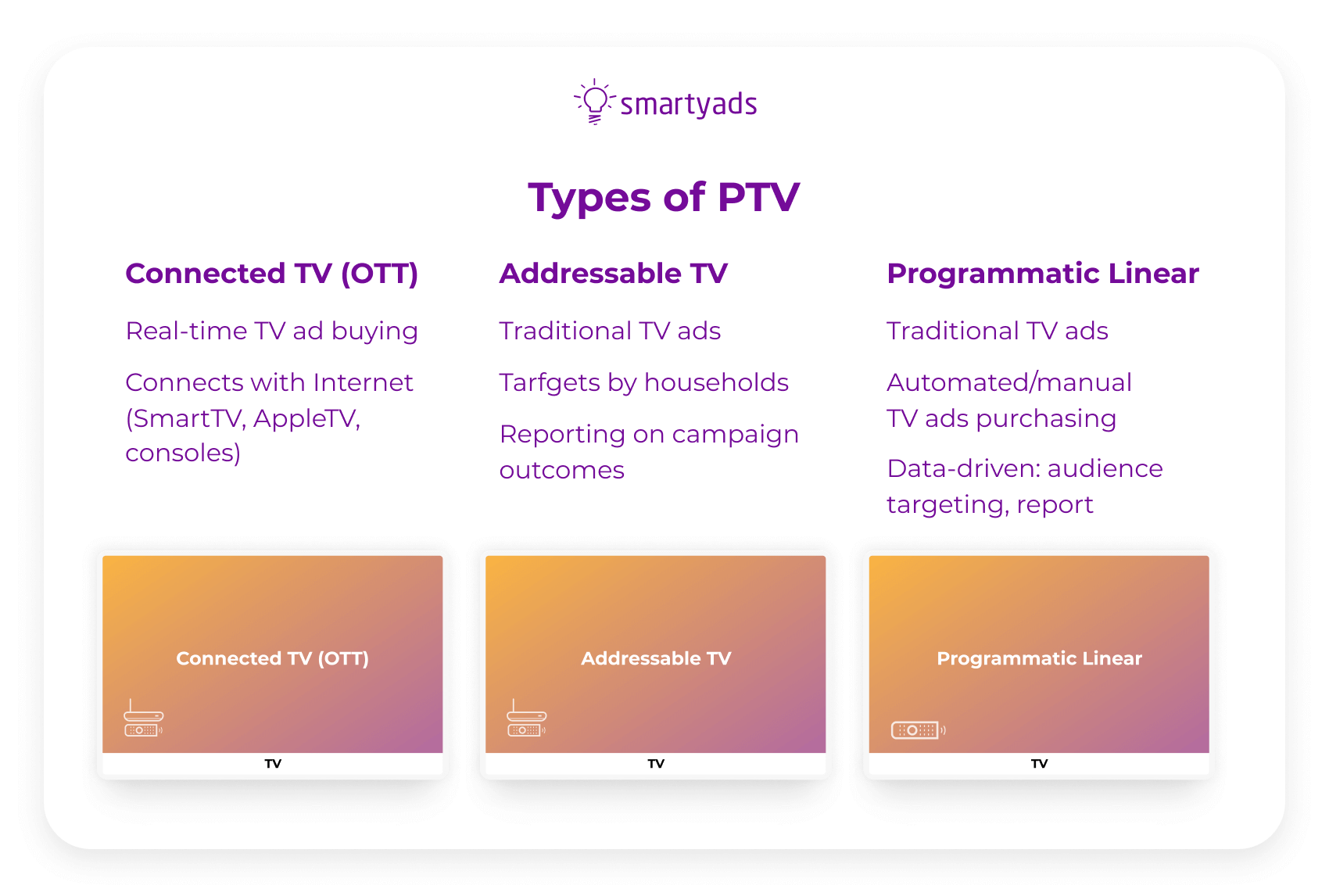
How to buy OTT advertising programmatically
Just like content serving, advertising on OTT medium can be organized in various ways, however, advertising platforms based on programmatic technology (e.g like Amazon advertising for Amazon fire TV or Amazon prime video, or Google ads for YouTube TV) have become increasingly popular because they deliver automation, campaign precision, measurability, and targeting.
Why do advertisers and marketers prefer to launch their OTT campaigns through programmatic platforms?
Saving budgets
Programmatic demand-side platforms help advertisers buy ads without inventing tremendous resources in the search for the right media.
DSPs automate and simplify media buying, automatically filling ad placement based on campaign criteria (targeting, available budget). This helps to achieve better ROI and campaign effectiveness with a humble budget.
Measuring KPIs
Programmatic OTT platforms make TV advertising as measurable as ads on the web. They apply a definite set of metrics for assessing campaign performance. The most popular of those are impression metrics since OTT ads are usually used for branding campaigns.
Setting the most precise OTT targeting
Barely anything can measure up to programmatic targeting capabilities that may include dozens of targeting criteria with data provided directly by connected publishers (geo, device type, language, age range, etc).
The last word
OTT digital advertising is booming. Leveraging it to its fullest potential will become a priority for many businesses; brands will buy OTT inventory and advertise on it since there’s nothing more engaging and immersive for users than big-screen TVs.
Advertise on connected TV globally on SmartyAds DSP!

